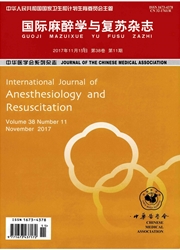

 中文摘要:
中文摘要:
目的研究在脑缺血性损伤时增强γ-氨基丁酸(GABA)受体的活化对神经型一氧化氮合酶(nNOS)磷酸化的影响,进一步探讨抑制性神经递质在缺血再灌注中作用的分子信号机制。方法制备SD大鼠大脑四动脉结扎模型,联合给予GABAA受体的激动剂蝇蕈醇和GABAB受体的激动剂氯苯氨丁酸;采用免疫印迹、免疫沉淀等技术,检测各实验组nNOS磷酸化的水平变化。结果缺血再灌注1d时nNOS(Ser847)的磷酸化达最低水平,联合给予蝇蕈醇和氯苯氨丁酸能增强缺血再灌注1d时的nNOS(Ser847)磷酸化。结论 GABAA、GABAB受体共活化通过增加nNOS(Ser847)的磷酸化对缺血后神经元有保护作用。
 英文摘要:
英文摘要:
Objective This study is to investigate the role of enhancement of GABA receptor activity on the phosphorylation of nNOS and the possible molecular mechanisms of inhibitory neurotransmission during brain ischemia. Methods Adult male Sprague-Dawley rats were used to induce four-vessel occlusion cerebral ischemia models,combination of GABA receptor agonists (muscimol and baclofen) was used. And we used immunoprecipitation and western blotting to observe nNOS(Ser847) phosphorylation.Results Combination of two agonists could increase the interaction of nNOS with PSD95 and nNOS(Ser847) phosphorylation at 1 day reperfusion. Conclusion Co-application of GABA receptor agonists could exert its neuroprotective effect on cerebral ischemia by increasing nNOS (Ser847) phosphorylation.
 同期刊论文项目
同期刊论文项目
 同项目期刊论文
同项目期刊论文
 Neuroprotection of ethanol against cerebral ischemia/reperfusion induced brain injury through GABA r
Neuroprotection of ethanol against cerebral ischemia/reperfusion induced brain injury through GABA r Co-activation of GABA receptors inhibits the JNK3 apoptotic pathway via the disassembly of the GluR6
Co-activation of GABA receptors inhibits the JNK3 apoptotic pathway via the disassembly of the GluR6 Activation of GABA receptors attenuates neuronal apoptosis through inhibiting the tyrosine phosphory
Activation of GABA receptors attenuates neuronal apoptosis through inhibiting the tyrosine phosphory Preconditioning ischemia attenuates increased neurexin-neuroligin1-PSD-95 interaction after transien
Preconditioning ischemia attenuates increased neurexin-neuroligin1-PSD-95 interaction after transien Neuroprotection of gamma-aminobutyric acid receptor agonists via enhancing neuronal nitric oxide syn
Neuroprotection of gamma-aminobutyric acid receptor agonists via enhancing neuronal nitric oxide syn 期刊信息
期刊信息
